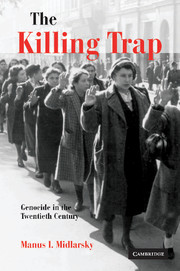Book contents
- Frontmatter
- Contents
- Preface
- PART I Introduction
- PART II Explaining perpetrators: theoretical foundations
- PART III The theory applied
- PART IV Victim vulnerability: explaining magnitude and manner of dying
- 10 Raison d'état, raison d'église
- 11 Cynical realpolitik and the unwanted
- 12 High victimization: the role of realpolitik
- 13 Inequality and absence of identification
- 14 On the possibility of revolt and altruistic punishment
- PART V Exceptions
- PART VI Conclusion
- References
- Index
13 - Inequality and absence of identification
Published online by Cambridge University Press: 22 September 2009
- Frontmatter
- Contents
- Preface
- PART I Introduction
- PART II Explaining perpetrators: theoretical foundations
- PART III The theory applied
- PART IV Victim vulnerability: explaining magnitude and manner of dying
- 10 Raison d'état, raison d'église
- 11 Cynical realpolitik and the unwanted
- 12 High victimization: the role of realpolitik
- 13 Inequality and absence of identification
- 14 On the possibility of revolt and altruistic punishment
- PART V Exceptions
- PART VI Conclusion
- References
- Index
Summary
Genocide, as we have seen, is a massive event that lends itself to analysis at various levels. As before, most of this chapter and its successor concentrate on the victims, a necessary addition to the analysis. Here we continue our exploration at the societal level as a means of understanding two things: (1) how so many perpetrators could be induced (of their own will or otherwise) to commit mass murder and (2) how so many victims, especially in the Holocaust, could be persuaded to collaborate in their own annihilation.
One perspective enables us to shed light on both questions; it emerges from our initial identification of the centrality of loss in the form of the diminution of socioeconomic space experienced by both perpetrator and victim, although at different times. Earlier, we saw the emotional and cognitive reaction of perpetrators to the consequence of contraction. The pitiful or at least unsettling condition of refugees and economic chaos were principal consequences of territorial loss. Now we focus on an additional consequence of loss – the nexus between inequality and identification, and how the interplay between the two variables affects victimization. Specifically, economic scarcity leads to economic inequality between individuals and groups, which in turn limits the ability to establish mutual identifications among the goals and life circumstances of the affected parties.
- Type
- Chapter
- Information
- The Killing TrapGenocide in the Twentieth Century, pp. 264 - 286Publisher: Cambridge University PressPrint publication year: 2005



